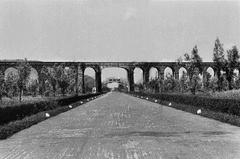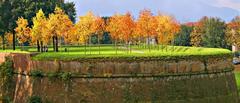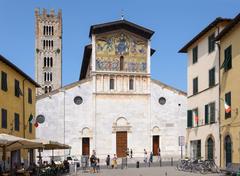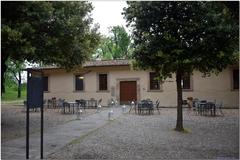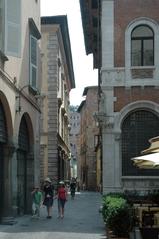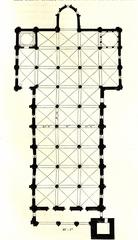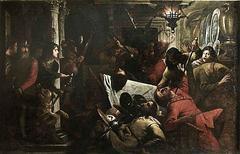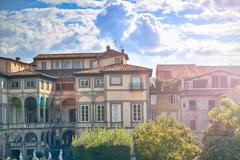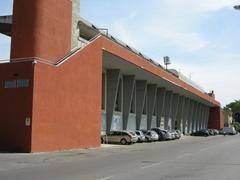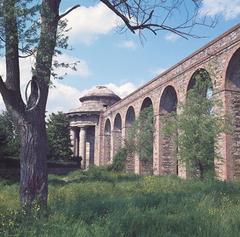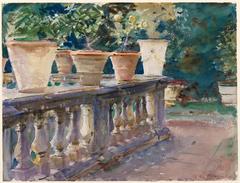Baluardo di Santa Maria: Visiting Hours, Tickets, and Comprehensive Travel Guide for Lucca, Italy
Date: 14/06/2025
Introduction
Baluardo di Santa Maria, a striking bastion embedded within Lucca’s iconic Renaissance city walls, stands as both a symbol of the city’s military ingenuity and a vibrant contemporary landmark. Originally constructed in the mid-16th century as part of Lucca’s advanced fortification system, this bastion exemplifies Renaissance military architecture while seamlessly blending into the city’s modern urban fabric. Today, Baluardo di Santa Maria is not only a testament to Lucca’s historical resilience but also a beloved destination for leisure, culture, and panoramic vistas, making it a must-visit site for travelers of all interests (Le Mura di Lucca - Identità e Città; Walls of Lucca - Wikipedia).
This guide provides detailed information on the bastion’s history, architecture, cultural role, practical visitor details (including hours and ticketing), accessibility, nearby attractions, travel tips, and frequently asked questions. Whether you are a history enthusiast, a culture seeker, or simply looking for a scenic stroll, Baluardo di Santa Maria offers a unique window into Lucca’s enduring heritage (The Crazy Tourist; Italy With Patri).
Table of Contents
- Introduction
- Historical Background
- Architectural Features
- Cultural and Civic Role
- Visiting Information
- Activities and Events
- Nearby Attractions
- Frequently Asked Questions (FAQ)
- Practical Travel Tips
- Conclusion
- References
Historical Background
Origins and Construction
Baluardo di Santa Maria emerged as part of Lucca’s ambitious Renaissance fortification project, designed to protect the city from evolving artillery threats during the 16th century. The new walls and bastions, including Santa Maria, were constructed between 1513 and 1650, following the strategic vision of local authorities and renowned military engineers. The bastion’s distinctive “a musone” (beak-shaped) design, with squared flanks and massive brick ramparts, reflects contemporary advancements in military architecture (Le Mura di Lucca - Identità e Città; Lucca Mura Urbane - History).
Strategic and Symbolic Significance
Positioned between Porta San Pietro and Baluardo San Paolino, Baluardo di Santa Maria was strategically placed to safeguard a primary city gate. Its imposing structure and the Madonna emblem atop the bastion symbolize both Lucca’s defensive prowess and its spiritual identity (Caffè delle Mura - Turismo Lucca; Walls of Lucca - Wikipedia).
Evolution into a Civic Landmark
By the 19th century, as military threats subsided, Lucca’s walls—including Baluardo di Santa Maria—were transformed into a public promenade by Duchess Maria Luisa di Borbone. The bastion became a green oasis for leisure and social gatherings, a tradition that continues today (Caffè delle Mura - Turismo Lucca; LuccaLive).
Architectural Features
Renaissance Military Engineering
Baluardo di Santa Maria exemplifies the robust design of Renaissance-era bastions, with thick brick walls (up to 30 meters wide at the base and 12 meters high), angular flanks for optimal defense, and subterranean galleries for troop movement and storage (turismo.lucca.it). Its polygonal shape allowed defenders to cover adjacent sections of the wall, while vaulted casemates inside once stored munitions and housed soldiers (florencetips.com).
Integration and Adaptive Reuse
The bastion is seamlessly integrated into the 4.2-kilometer circuit of Lucca’s city walls. In the 19th century, the ramparts were repurposed as a tree-lined promenade, and the historic Caffè delle Mura was established atop the bastion, further embedding it in Lucca’s social life (LuccaLive).
Subterranean Spaces
Restored underground galleries (casermette) offer insight into the site’s defensive past, accessible during special tours or cultural events (Turislucca).
Cultural and Civic Role
Symbol of Independence
Dedicated to Santa Maria, the bastion embodies Lucca’s autonomy, religious devotion, and civic pride (nomads-travel-guide.com). It has long been a prominent landmark in local art and iconography.
Present-Day Use
Baluardo di Santa Maria serves as a lively gathering place, offering panoramic views, space for leisurely walks and cycling, and hosting events such as Lucca Historiae Fest, concerts, and art exhibitions (turismo.lucca.it; Lucca What’s On).
Educational Opportunities
Interpretive panels and guided tours provide historical context, while cultural events highlight the bastion’s ongoing significance (turismo.lucca.it).
Visiting Information
Hours and Tickets
- Hours: The walls and bastions are accessible year-round, typically from dawn to dusk. The promenade is not gated and can be visited at any time.
- Tickets: Access is free. Some underground galleries or special events may require advance booking or ticket purchase (Turismo Lucca).
Accessibility
The path atop the walls is wide, flat, and surfaced with compacted gravel, suitable for strollers, wheelchairs, and bicycles. Access ramps are available at major gates and several bastions. Underground spaces may be less accessible due to stairs or uneven surfaces (northabroad.com).
Directions and Facilities
- Location: Baluardo di Santa Maria is near Porta San Pietro and Porta Santa Maria, within a 5–10 minute walk from Lucca’s train station and main parking areas (The Travel Folk).
- Facilities: Public restrooms and drinking fountains are available along the walls. The Caffè delle Mura atop the bastion offers refreshments (Caffè delle Mura - Turismo Lucca).
Activities and Events
- Walking and Cycling: The 4.2-kilometer wall circuit offers a scenic route for pedestrians and cyclists. Bike rentals are available near the city gates (The Travel Folk).
- Picnicking: The bastion’s shaded lawns are ideal for picnics.
- Photography: Elevated viewpoints provide excellent opportunities for capturing Lucca’s skyline and the surrounding countryside.
- Cultural Events: Attend open-air concerts, art exhibitions, historical reenactments, and seasonal festivals, especially during Lucca Historiae Fest (Turismo Lucca).
Nearby Attractions
- Piazza dell’Anfiteatro: A unique oval piazza built on a Roman amphitheater.
- Cathedral of San Martino: Renowned for Romanesque architecture and art.
- Guinigi Tower: Famous for its rooftop oak garden.
- Orto Botanico di Lucca: Botanical gardens adjacent to the walls.
- Via Fillungo: The city’s main shopping street with cafés and gelaterias (Lonely Planet).
Frequently Asked Questions (FAQ)
Q: Do I need a ticket to visit Baluardo di Santa Maria?
A: No, access is free and open to all. Some special exhibitions or underground tours may require tickets.
Q: What are the typical opening hours?
A: The walls and bastions are generally open year-round, accessible from dawn to dusk, with no formal restrictions.
Q: Is the site wheelchair accessible?
A: Yes, the promenade is accessible via ramps and is suitable for wheelchairs and strollers. Underground galleries may have limited access.
Q: Are guided tours available?
A: Yes, guided tours of Lucca’s walls and bastions are offered by local operators and can be booked in advance.
Q: Are there facilities such as toilets and cafes?
A: Yes, public restrooms are located at intervals along the walls, and the Caffè delle Mura atop the bastion provides refreshments.
Practical Travel Tips
- Best Times to Visit: Spring and autumn offer mild weather and fewer crowds. Early mornings and evenings are quieter and provide the best light for photography.
- What to Bring: Comfortable walking shoes, water, snacks, sun protection, and a camera.
- Etiquette: Respect shared paths, dispose of litter responsibly, and greet locals during the traditional passeggiata.
- Safety: The site is well-maintained, but supervision is recommended for children near wall edges. Cyclists should yield to pedestrians.
- Language: English is widely spoken, but basic Italian greetings are appreciated.
Conclusion
Baluardo di Santa Maria is a remarkable fusion of Lucca’s military history, architectural mastery, and vibrant community life. Whether you are captivated by Renaissance fortifications, seeking panoramic views, or simply enjoying a leisurely stroll, this bastion is a quintessential Lucca experience. Take advantage of the free access, participate in local events, and explore the adjacent attractions for a memorable visit.
For more information, download the Audiala app for guided tours and insider tips. Follow Audiala on social media to stay updated on upcoming events, festivals, and cultural experiences in Lucca.
References
- Le Mura di Lucca - Identità e Città - Zingarate Blog
- Caffè delle Mura - Turismo Lucca
- Walls of Lucca - Wikipedia
- Baluardo Bastion on Lucca’s Wall - Bagni di Lucca Blog
- Lucca Mura Urbane - History
- Mura di Lucca - Itinerary Expert
- The Crazy Tourist - 15 Best Things to Do in Lucca
- Italy With Patri - Lucca Walls and Ramparts
- Nomads Travel Guide - Lucca
- Turismo Lucca - Walk City Walls Lucca
- LuccaLive - Le Bellezze del Nostro Territorio: Le Mura di Lucca
- The Travel Folk - One Day in Lucca, Italy
